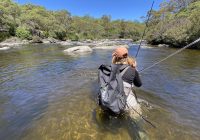Planning, prepping and checking your vessel leads to an even greater experience on the water for all. We cover the basis for developing your own luxury motor yacht pre-departure checklist.
Whether you are new to boating, or on your fourth Maritimo, being the Master of your vessel comes with a level of responsibility for all those you take on board. So rather than be alarmist, let’s get on with the fun by first taking a moment to run through some basics that you can incorporate into your boating regime, and thereby make the most of your time on the water. At the end of this article you will find our luxury motor yacht pre-departure checklist that you can use as the basis to develop your own that will be specific to you and your vessel.
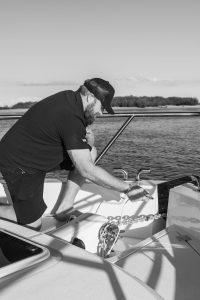
Maritimo’s Delivery Skipper, Isaac Marshall, is a Master Four qualified mariner with years of experience across many a vessel, and in various locales around the globe. “We all want to get out there and have fun and enjoy our hobbies. I think the most dangerous thing on the water recreationally is that on a good year we may only use our boat once a fortnight or month. It is not a lot when you compare it to other activities we undertake. Boating does have its risks, but with careful planning and consideration you can mitigate many of them”, said Marshall.
“There are key things you can do that are imperative to a good day’s boating, and much of it starts by turning your mind to the task at hand before you even step on board. This particular message cannot ever be overstated. Having your own checklist is the best way to do ensure you are at your best, and make everyone comfortable in the process. It does not have to be overcomplicated, either. Simply put, just know your boat.”

“Do some key things at the start of the day, during the day on a longer trip and at the end of the day, like inspect the engine room. If things are different, then an analysis needs to be done. Even with just this one simple procedure you’ll be halfway to not only having a safe day on the water, but an enjoyable one too.”
“Rule zero would be check the weather and tides the night before, and then again in the morning before you leave your house, as you may have to change your departure time to suit. Rule one would be get there half an hour before your guests arrive or your planned departure time.”
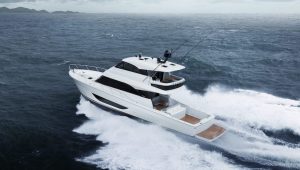
“You will create your own version, and it might be ten steps, or it might be fifty. It could be a notebook, or list by the helm, but your own version is just that. Yours. Stick to it.”
This kind of thing is more than just bringing things back online, checking batteries, oil, filters, running fans, warming diesels, and checking your chartplotter, including zooming in to look for any anomalies. There is also having the correct safety gear for all people on board, which will avoid fines if nothing else. Of course, logging your float plan with the Coast Guard, and also a family member or friend staying ashore, is just plain smart.
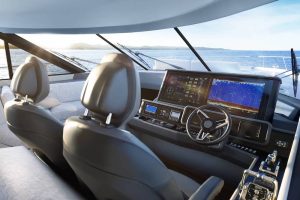
“So, you’re straight on board, to check bilges, filters, fuel, and the isolators on the batteries. From there you can sweep over the boat from stem to stern to look for changes or damage. Tenders not held down, open portholes, and a loose or non-existent anchor/chain lock are just a couple of the most common items taken for granted.”
“These days we have things like automatic charge relays, so it kind of negates the need for isolators to be turned on and off, as you can actually do that from up near the helm. With the engines, you do not have to drain the condensation cans anymore, but you do want to warm them up before leaving the quay. As we have said, knowing your boat is crucial. With a Twin Disc gearbox you check the transmission fluid when it is idling, and warm, whereas with the ZF boxes, you have to start the mains, then shut them down, and then check them.”

Whilst it may seem overkill to check the fluids on Friday, when you last used the boat on Tuesday, for the extra few minutes it can alert you to any changes in colour or reduction in level, which can be significant. None the less, you want to have a dry bilge. You want to make sure the bilges are clean and free of any stale water or oil from the previous run.
“Once you’re done below, you can head upstairs to your breaker panel, and start to bring things back online, even when you have C-Bus running things. There will be items you turn on when you’re going for a day trip, and other things you turn on for nighttime.”
“As you are there, you can bring your passage plan over to your nav gear, like Active Captain with Navionics for Garmin, bring your radar up, tune it and make sure your vessel orientation is correct. Also, it is time to check that the cameras are coming up, as there are so many spots on a boat where from the bridge you cannot see your guests, so make sure your aft and side decks are part of your camera set up. They must let you know if they plan to move, especially along a side deck to the bow.”
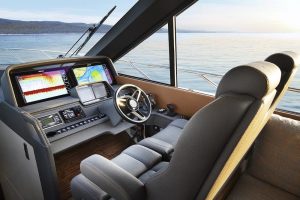
“From there it is time to greet your guests and explain where the safety gear is, where your muster station is, how to deal with fires and medical issues, as well as sea sickness, which debilitates people swiftly and on a long passage is just awful for all on board. Hydration, and that means water, keeps many people in better places whilst at sea. Also, take some bottled water, in case you have issues with your tanks, pumps, or desalinator unit.
“I do recommend having a defribulator on board, as it can save lives. You certainly don’t want to alarm people, but keeping a light hand when dealing with things like flushing the toilet makes sure everyone pays attention the whole way through your briefing.”
“Equally, by showing that you are all over it, you will make people feel very safe. Explain how long the voyage should be, and what the conditions are meant to be. Letting them know what to do if you become incapacitated, like just stopping the boat so you do not injure anyone else or the environment; this could be anchoring if inshore, or just simply drifting if you are offshore. That way they can concentrate on you and then get onshore assistance, if required.”
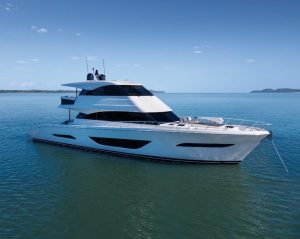
“When you are done with the safety talk, you can remind them that they’re going to have a fun day. By you taking responsibility for the lives of your guests you will reduce the chance for negative things to occur, along with your stress, and significantly enhance the memories for all.”
“Ultimately, do not be frightened to have some aide memoirs on the bridge – a plan, a VHF calling card, channel mark identifier, and code flag chart. These can be of as much help to you as your briefing to your guests. In the age of electronics, also make sure your charts have been updated before you depart”, said Marshall by way of adding even more assistance for Skippers.
Maritimo Pre-Departure Checklist
Please use this as the basis for developing your own luxury motor yacht checklist:
- Check the Weather and Tides: Review current conditions and forecasts the night before and in the morning.
- Plot Your Route: Develop your passage plan and log it.
- Arrive Early: Reach your Maritimo well in advance.
- Survey the Engine Room: Inspect plant and equipment for any issues.
- Power your luxury yacht back up: Switch on master controls and get devices back online.
- Inspect the Yacht: Walk over your Maritimo and check from stem to stern.
- Warm the Main Engines: Allow time for the engines to warm up.
- Ensure Electronics Function: Verify that all electronics are operational and tuned to the correct settings.
- Greet Guests: Welcome your guests and explain safety and medical procedures and equipment locations.
- Prioritise Safety, Fun, and Wellbeing: Ensure a safe environment to maximise enjoyment on the water for all.
From the team at www.maritimo.com.au





